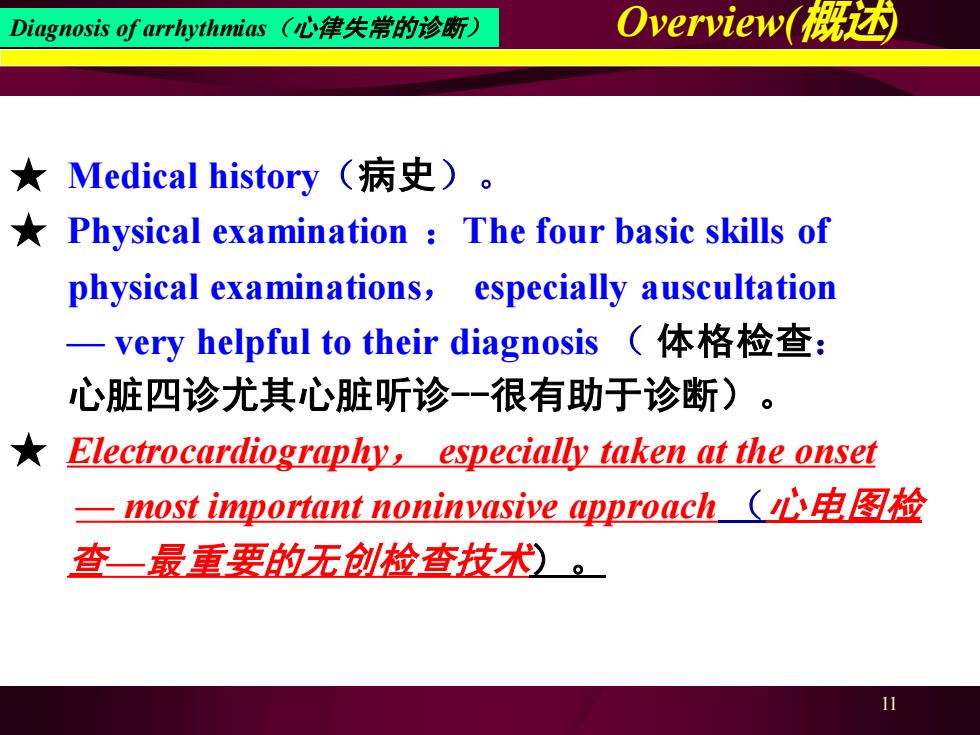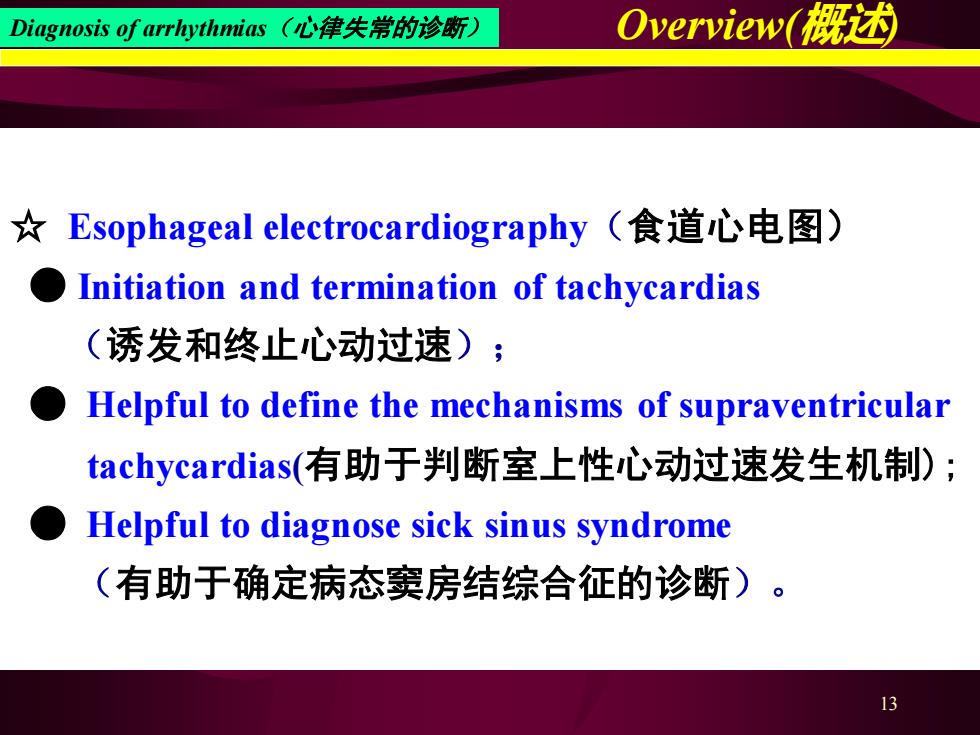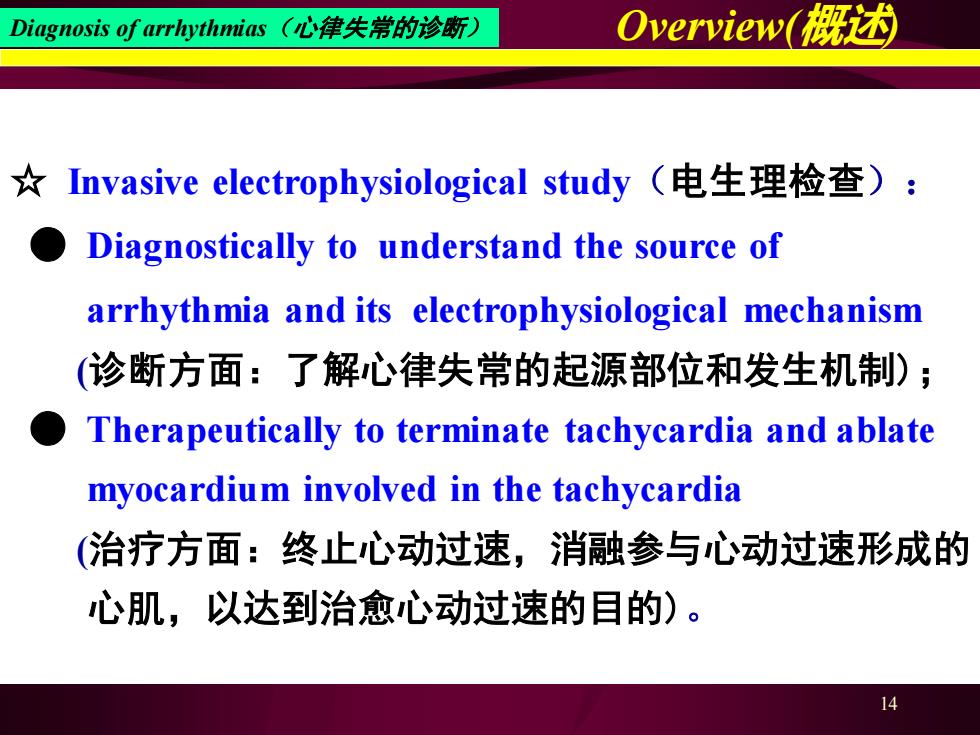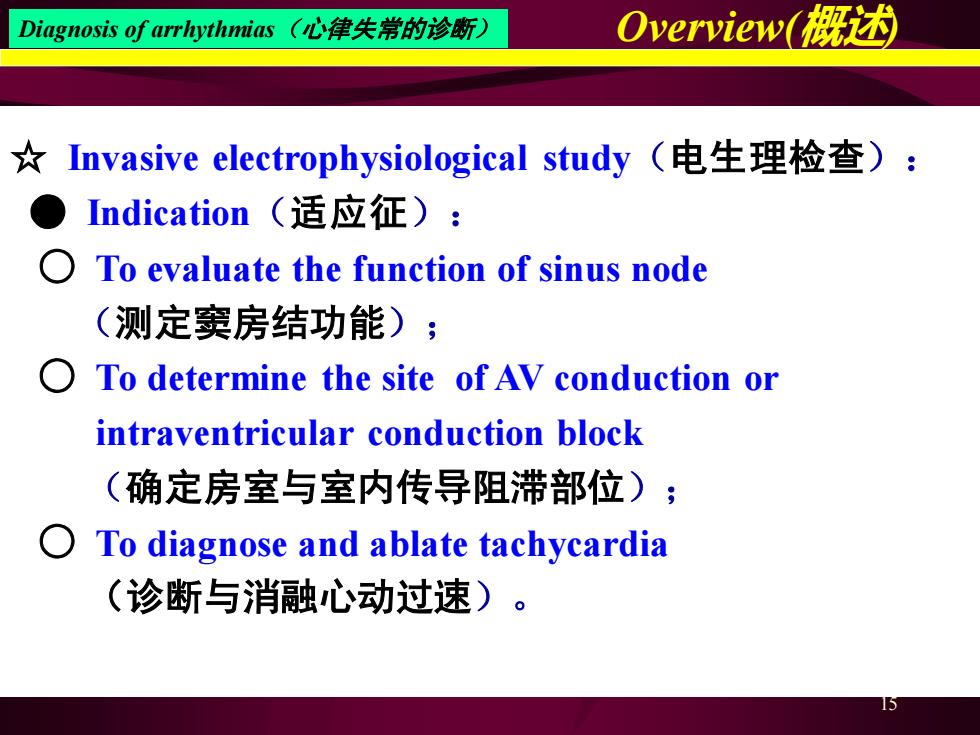
Diagnosis of arrhythmias(心律失常的诊断) Overview(概述 ★Medical history(病史)。 *Physical examination The four basic skills of physical examinations,especially auscultation 一very helpful to their diagnosis(体格检查: 心脏四诊尤其心脏听诊-一很有助于诊断)。 Electrocardiography,especially taken at the onset 一ost imp0tntn0 ninvasive approach.(心电图检 查一最重要的无创检查技术)。 11
11 ★ Medical history(病史)。 ★ Physical examination :The four basic skills of physical examinations, especially auscultation — very helpful to their diagnosis ( 体格检查: 心脏四诊尤其心脏听诊-很有助于诊断)。 ★ Electrocardiography, especially taken at the onset — most important noninvasive approach (心电图检 查—最重要的无创检查技术)。 Diagnosis of arrhythmias(心律失常的诊断) Overview(概述)

Diagnosis of arrhythmias(心律失常的诊断) Overview(概述 ☆Prolonged ECG monitoring(长时间心电图记录): ●Holter ECG monitoring(动态心电图记录): O Noninvasive、portable、convenient (无创、便携式和方便); O To determine the relationship of palpitation or syncope to arrhythmias (明确心悸或晕厥与心律失常的关系): O To determine the relationship of ischemia to daily activity(明确心肌缺血与日常活动的关系); O To assess antiarrhythmic drug efficacy and pacemaker function (评价抗心律失常药物疗效、起搏器工作情况)
12 ☆ Prolonged ECG monitoring(长时间心电图记录): ● Holter ECG monitoring(动态心电图记录): ○ Noninvasive、 portable 、convenient (无创、便携式和方便); ○ To determine the relationship of palpitation or syncope to arrhythmias (明确心悸或晕厥与心律失常的关系); ○ To determine the relationship of ischemia to daily activity(明确心肌缺血与日常活动的关系); ○ To assess antiarrhythmic drug efficacy and pacemaker function (评价抗心律失常药物疗效、起搏器工作情况)。 Diagnosis of arrhythmias(心律失常的诊断) Overview(概述)

Diagnosis of arrhythmias(心律失常的诊断) Overview(概述 ☆Esophageal electrocardiography(食道心电图) Initiation and termination of tachycardias (诱发和终止心动过速); Helpful to define the mechanisms of supraventricular tachycardias(有助于判断室上性心动过速发生机制); Helpful to diagnose sick sinus syndrome (有助于确定病态窦房结综合征的诊断)。 13
13 ☆ Esophageal electrocardiography(食道心电图) ● Initiation and termination of tachycardias (诱发和终止心动过速); ● Helpful to define the mechanisms of supraventricular tachycardias(有助于判断室上性心动过速发生机制); ● Helpful to diagnose sick sinus syndrome (有助于确定病态窦房结综合征的诊断)。 Diagnosis of arrhythmias(心律失常的诊断) Overview(概述)

Diagnosis of arrhythmias(心律失常的诊断) Overview(概述 ☆Invasive electrophysiological study(电生理检查): Diagnostically to understand the source of arrhythmia and its electrophysiological mechanism (诊断方面:了解心律失常的起源部位和发生机制); ● Therapeutically to terminate tachycardia and ablate myocardium involved in the tachycardia (治疗方面:终止心动过速,消融参与心动过速形成的 心肌,以达到治愈心动过速的目的)
14 Diagnosis of arrhythmias(心律失常的诊断) Overview(概述) ☆ Invasive electrophysiological study(电生理检查): ● Diagnostically to understand the source of arrhythmia and its electrophysiological mechanism (诊断方面:了解心律失常的起源部位和发生机制); ● Therapeutically to terminate tachycardia and ablate myocardium involved in the tachycardia (治疗方面:终止心动过速,消融参与心动过速形成的 心肌,以达到治愈心动过速的目的)

Diagnosis of arrhythmias(心律失常的诊断) Overview(概述 ☆nvasive electrophysiological study(电生理检查): ●ndication(适应征): O To evaluate the function of sinus node (测定窦房结功能); To determine the site of AV conduction or intraventricular conduction block (确定房室与室内传导阻滞部位); ) To diagnose and ablate tachycardia (诊断与消融心动过速)
15 ☆ Invasive electrophysiological study(电生理检查): ● Indication(适应征): ○ To evaluate the function of sinus node (测定窦房结功能); ○ To determine the site of AV conduction or intraventricular conduction block (确定房室与室内传导阻滞部位); ○ To diagnose and ablate tachycardia (诊断与消融心动过速)。 Diagnosis of arrhythmias(心律失常的诊断) Overview(概述)